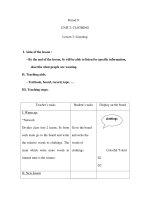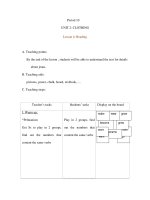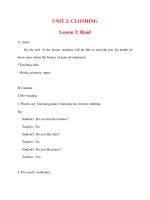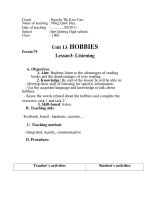Unit 2 Urbanisation Lesson 3 Reading
Bạn đang xem bản rút gọn của tài liệu. Xem và tải ngay bản đầy đủ của tài liệu tại đây (2.21 MB, 23 trang )
<span class='text_page_counter'>(1)</span>
<span class='text_page_counter'>(2)</span> URBANISATIO N Lesson 2: READING. Urbanisation and its causes.
<span class='text_page_counter'>(3)</span> In the countryside in Africa.
<span class='text_page_counter'>(4)</span> Cairo city in Egypt, in Africa.
<span class='text_page_counter'>(5)</span> Woman at work in Cairo.
<span class='text_page_counter'>(6)</span> In the countryside in South.
<span class='text_page_counter'>(7)</span> In city in Argentina in South America.
<span class='text_page_counter'>(8)</span> In the countryside in Vietnam.
<span class='text_page_counter'>(9)</span> City in Vietnam.
<span class='text_page_counter'>(10)</span> A woman at work in Hahoi,.
<span class='text_page_counter'>(11)</span> In city in Vietnam.
<span class='text_page_counter'>(12)</span> What do you think about life n the countryside and life in ci.
<span class='text_page_counter'>(13)</span> Predict whether the sentences are true or false.. ACTIVITY 1.. 1. Urbanisation happened first in more economically developed countries, then in less economically developed countries. 2. Urbanisation has increased in rich countries since 1950s..
<span class='text_page_counter'>(14)</span> ACTIVITY 1. Predict whether the. sentences are true or false.. 3. Lack of resources in rural areas is one of the factors leading to urbanisation in less developed countries. 4. The standard of living in cities and rural areas is more or less the same. 5. By 2050, more than two thirds of the world’s population are expected to live in urban areas..
<span class='text_page_counter'>(15)</span> ACTIVITY 2. Check your predictions in 1. 1. T 2. F 3. T 4. F 5. T.
<span class='text_page_counter'>(16)</span> Find the words in the text that have the following meanings.. ACTIVITY 3.. . 1. expanding 2. counter-urbanization 3. doubled 4. increase 5. migrate.
<span class='text_page_counter'>(17)</span> ACTIVITY 4. Answer the. questions.. 1. It’s a process by which urban areas grow bigger as more and more people leave the countryside to live in towns and cities. 2. MEDCs stands for more economically developed countries. LEDCs stands for less economically developed countries..
<span class='text_page_counter'>(18)</span> ACTIVITY 4. Answer the. questions.. 3. Before the 1950s, rapid urbanization took place in Europe and North America because it was the period of industrialization in these areas. 4. After 1950 the urbanization started to grow rapidly in LEDCs..
<span class='text_page_counter'>(19)</span> ACTIVITY 4. Answer the. questions.. 5. Some of the ‘push’ factors of urbanization are lack of resources in rural areas, bad weather conditions, and competition from large agricultural companies. 6. Because they have to suffer bad weather conditions , and competition from large agricultural companies..
<span class='text_page_counter'>(20)</span> ACTIVITY 4. Answer the. questions.. 7. Some of the ‘pull’ factors of urbanization are the centralization of resources such as money, services, wealth and opportunities as well as the higher living standards of these areas..
<span class='text_page_counter'>(21)</span> ACTIVITY 5. Discuss with a partner. How has your area been affected by urbanization?.
<span class='text_page_counter'>(22)</span> - Read the passage fluently and learn the new words from the reading by heart - Prepare the new lesson: SPEAKING.
<span class='text_page_counter'>(23)</span> THANK YOU FOR YOUR ATTENTION.
<span class='text_page_counter'>(24)</span>









